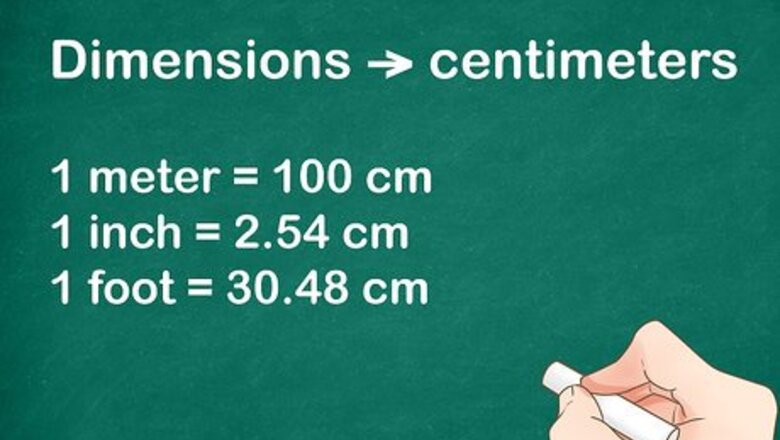
views
X
Research source
Liters are a common measurement often used to measure beverages and other liquids, such as a 2 liter bottle of soda. Sometimes you will need to calculate the volume of an object in liters, given the object's dimensions. In other instances, you will need to convert the volume of something that is already given in another unit, such as milliliters or gallons. In all of these instances, through simple multiplication or division, you can easily determine volume in liters.
Finding Volume in Liters from Dimensions
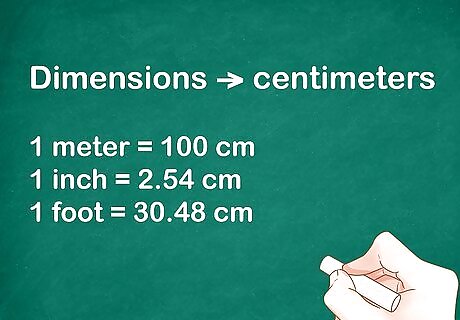
Convert the dimensions to centimeters. If the dimensions are given in meters, inches, feet, or some other unit of measurement, convert each dimension to centimeters (cm) before calculating the volume. This will make it easier to convert to liters. Always double-check that the dimensions of the shape you're working with have the same unit before you calculate the volume.Key Conversions1 meter = 100 centimeters. So, if the length of a cube is 2.5 meters, that converts to 250 centimeters, since 2.5 × 100 = 250 {\displaystyle 2.5\times 100=250} 2.5\times 100=250.1 inch = 2.54 centimeters. So, if the length of a cube is 5 inches, that converts to 12.7 centimeters, since 5 × 2.54 = 12.7 {\displaystyle 5\times 2.54=12.7} 5\times 2.54=12.7.1 foot = 30.48 centimeters. So, if the length of a cube is 3 feet, that converts to 91.44 centimeters, since 3 × 30.48 = 91.44 {\displaystyle 3\times 30.48=91.44} 3\times 30.48=91.44.
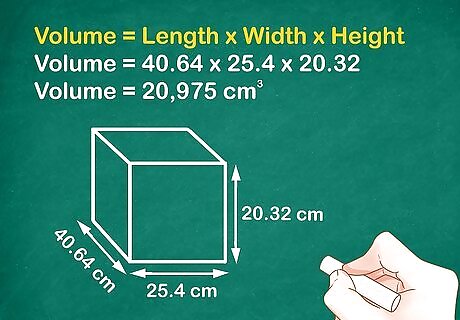
Find the volume of the shape. How you find the volume will depend on the shape of the three-dimensional object you are measuring, since the volume of each type of shape is calculated differently. To find the volume of a cube, you can use the formula Volume = Length × Width × Height {\displaystyle {\text{Volume}}={\text{Length}}\times {\text{Width}}\times {\text{Height}}} {\text{Volume}}={\text{Length}}\times {\text{Width}}\times {\text{Height}}. The volume of a three-dimensional shape will be in cubic units, such as cubic centimeters ( c m 3 {\displaystyle cm^{3}} cm^{{3}}). For instance, if a fish tank is 40.64 cm long, 25.4 cm wide, and 20.32 tall you would calculate the volume by multiplying these dimensions together: Volume = Length × Width × Height {\displaystyle {\text{Volume}}={\text{Length}}\times {\text{Width}}\times {\text{Height}}} {\text{Volume}}={\text{Length}}\times {\text{Width}}\times {\text{Height}} Volume = 40.64 × 25.4 × 20.32 {\displaystyle {\text{Volume}}=40.64\times 25.4\times 20.32} {\text{Volume}}=40.64\times 25.4\times 20.32 Volume = 20 , 975 c m 3 {\displaystyle {\text{Volume}}=20,975cm^{3}} {\text{Volume}}=20,975cm^{{3}} To find the volume of a cylinder, start by finding the height h {\displaystyle h} h of the cylinder. Then, find the radius of the circle at the top or bottom. Next, find the area of the circle, which you can find with the formula π r 2 {\displaystyle r^{2}} r^{2}, where r is the radius. Finally, multiply the area of the circle by the height of the cylinder to find the volume. Volume {\displaystyle {\text{Volume}}} {\displaystyle {\text{Volume}}}cylinder = {\displaystyle =} {\displaystyle =} π r 2 h {\displaystyle r^{2}h} {\displaystyle r^{2}h}
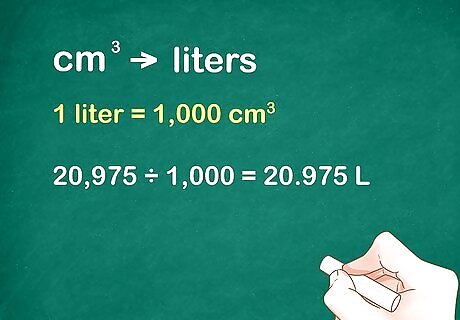
Convert cubic centimeters to liters. To do this, use the conversion rate 1 liter = 1 , 000 c m 3 {\displaystyle 1\;{\text{liter}}=1,000cm^{3}} 1\;{\text{liter}}=1,000cm^{{3}}. Dividing the volume (in cubic centimeters) of the shape by 1,000 will give you the volume in liters (L). If the volume of the fish tank, in cubic centimeters, is 20,975, to find the volume in liters, calculate 20 , 975 ÷ 1 , 000 = 20.975 {\displaystyle 20,975\div 1,000=20.975} 20,975\div 1,000=20.975. So, a fish tank that is 40.64 cm long, 25.4 cm wide, and 20.32 tall has a volume of 20.975 L.
Converting Liters from other Metric Units
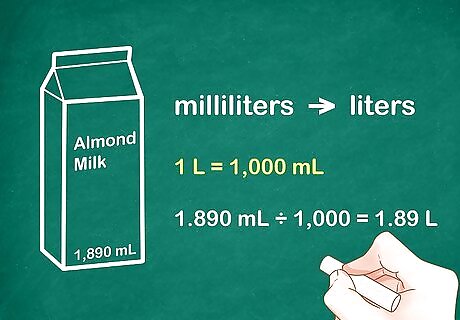
Convert milliliters to liters. There are 1,000 milliliters (mL) in 1 liter (L). So, to convert milliliters to liters, you would divide the number of milliliters by 1,000. If the volume of a carton of almond milk is 1,890 mL, to convert to liters, you would calculate 1 , 890 m L ÷ 1 , 000 = 1.89 L {\displaystyle 1,890mL\div 1,000=1.89L} 1,890mL\div 1,000=1.89L.
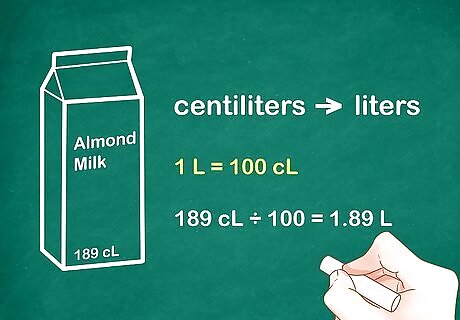
Convert centiliters to liters. There are 100 centiliters (cL) in 1 liter. So, to convert centiliters to liters, you would divide the number of centiliters by 100. If a the volume of a carton of almond milk is 189 cL, to convert to liters, you would calculate 189 c L ÷ 100 = 1.89 L {\displaystyle 189cL\div 100=1.89L} 189cL\div 100=1.89L.
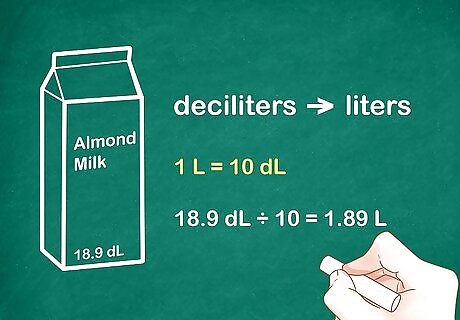
Convert deciliters to liters. There are 10 deciliters (dL) in 1 liter. So, to convert deciliters to liters, you would divide the number of deciliters by 10. If a the volume of a carton of almond milk is 18.9 dL, to convert to liters, you would calculate 18.9 d L ÷ 10 = 1.89 L {\displaystyle 18.9dL\div 10=1.89L} 18.9dL\div 10=1.89L.

Convert kiloliters to liters. There are 1000 liters in 1 kiloliter (kl). So, to convert kiloliters to liters, you would multiply the number of kiloliters by 1,000. If the volume of a kiddie pool is 240 kl, to convert to liters, you would calculate 240 k l × 1000 = 240 , 000 L {\displaystyle 240kl\times 1000=240,000L} 240kl\times 1000=240,000L.
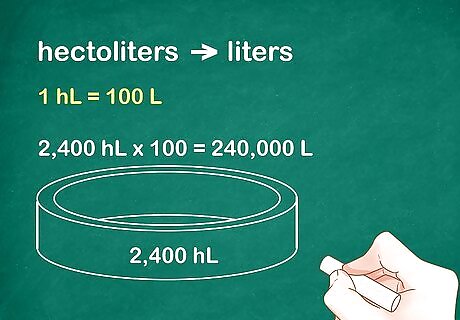
Convert hectoliters to liters. There are 100 liters in 1 hectoliter (hl). So, to convert hectoliters to liters, you would multiply the number of hectoliters by 100. If the volume of a kiddie pool is 2,400 hl, to convert to liters, you would calculate 2 , 400 h l × 100 = 240 , 000 L {\displaystyle 2,400hl\times 100=240,000L} 2,400hl\times 100=240,000L.

Convert decaliters to liters. There are 10 liters in 1 decaliters (dal). So, to convert decaliters to liters, you would multiply the number of decaliters by 10. If the volume of a kiddie pool is 24,000 dal, to convert to liters, you would calculate 24 , 000 d a l × 10 = 240 , 000 L {\displaystyle 24,000dal\times 10=240,000L} 24,000dal\times 10=240,000L.
Converting Liters from Imperial Units

Convert fluid ounces to liters. There are 33.81 fluid ounces (fl oz) in 1 liter. So, to convert fluid ounces to liters, you would divide the number of fluid ounces by 33.81. If a carton of almond milk is 128 fl oz, to convert to liters, you would calculate 128 f l o z ÷ 33.81 = 3.786 L {\displaystyle 128fl\;oz\div 33.81=3.786L} 128fl\;oz\div 33.81=3.786L.
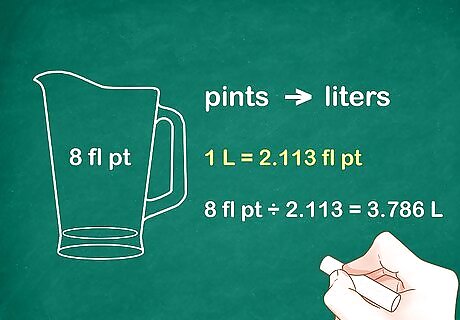
Convert pints to liters. There are 2.113 fluid pints (fl pt) in 1 liter. So, to convert fluid pints to liters, you would divide the number of fluid pints by 2.113. If a pitcher has a capacity of 8 fl pt, to convert to liters, you would calculate 8 f l p t ÷ 2.113 = 3.786 L {\displaystyle 8fl\;pt\div 2.113=3.786L} 8fl\;pt\div 2.113=3.786L.
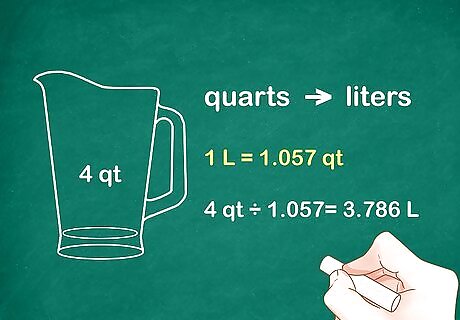
Convert quarts to liters. There are 1.057 quarts (qt) in 1 liter. So, to convert quarts to liters, you would divide the number quarts of by 1.057. If a pitcher has a capacity of 4 quarts, to convert to liters, you would calculate 4 q t ÷ 1.057 = 3.784 L {\displaystyle 4qt\div 1.057=3.784L} 4qt\div 1.057=3.784L.

Convert gallons to liters. There are 3.7854 liters in 1 gallon (gal). So, to convert gallons to liters, you would multiply the number gallons of by 3.7854. If a fish tank has a volume of 120 gallons, to convert to liters, you would calculate 120 g a l × 3.7854 = 454.248 L {\displaystyle 120gal\times 3.7854=454.248L} 120gal\times 3.7854=454.248L.













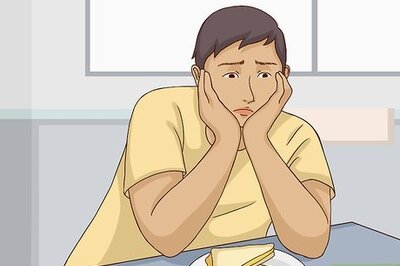


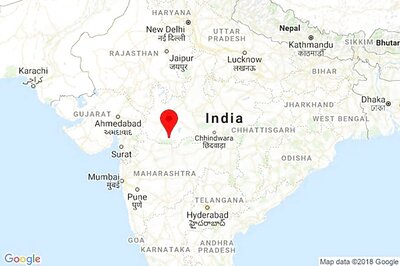
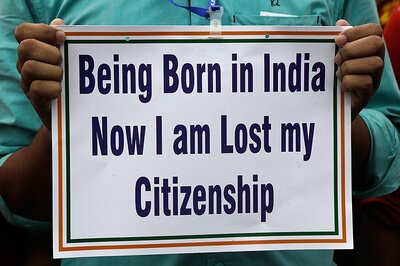
Comments
0 comment